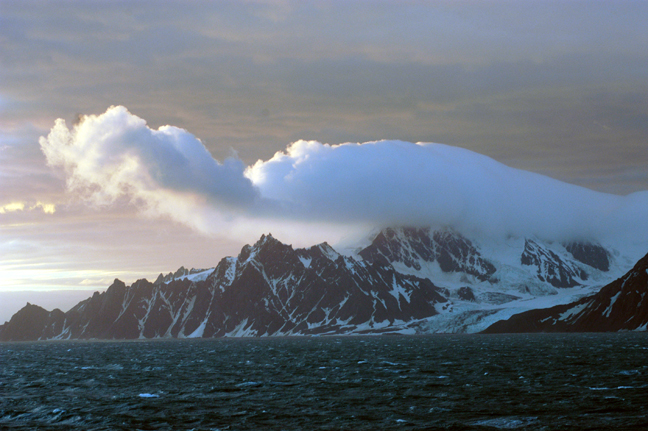In November 2002, UTIG researchers Fred Taylor, Cliff Frohlich, and graduate student Kris Gudipati, embarked on a NSF-funded project to study microplate motions in Antarctica using global positioning system (GPS) instruments. Neither Frohlich nor Gudipati had been to Antarctica previously. During the five-week field program aboard the research vessel Laurence M. Gould, Frohlich sent a series of letters and photographs to his friends and family describing what it was like to participate in this project. Published here, the letters and their belong to UTIG Senior Research Scientist Emeritus Cliff Frohlich.
From Cliff Frohlich, 16 December, 2002
Dear family & friends –
Finally, the weather has stopped being our friend down here. We have spent three days since I wrote you, sitting offshore of Elephant Island, hoping that the wind would calm down enough so that we could land and install a GPS site.
The day we after we arrived the wind died to about 20- 25 knots, so since we were in the lee of the island Skip decided to deploy the zodiak, figuring there would be less wind when we reached the beach.
Paradoxically, however, on the beach the wind was directed alongshore, steady at about 40 knots with gusts that must have been much higher. All of us got blown off our feet a couple of times, and the zodiak had some trouble avoiding rocks as we approached. So after we landed but before we could get started moving our GPS gear Skip lost his nerve, fearing that if it got worse we might not be able get back to the ship, and so we left shore after being on land only about ten minutes.
For the next two days we sat offshore, watching the weather, while Skip watched the shore through binoculars, smoke coming out of his ears. Among us scientists there was much discussion about how it was impossible for winds to be higher onshore in the lee of an island. The fact that we had observed this our very own selves meant either that:
- There was some kind of supernatural explanation that violated the laws of physics; or
- We didn’t really understand the laws of physics.
Now, since I have a Ph. D. in physics I held out for explanation 1. This meant that the logical approach would be to somehow appease the supernatural forces; say, by sacrificing a virgin. Unfortunately, the general feeling was that the ship’s complement of people and supplies probably didn’t include any virgins, so it appeared we might be in deep trouble.
Fortunately, yesterday the wind speed temporarily dropped to 6 knots. Thus a crack team was mobilized to go to shore again and deploy the GPS. I was a bit disappointed not be a part of this team; however, my primary assets are those of a physicist with known weak knees and a recently proven weak mind-these are not the most valuable assets when you are trying to land a zodiak in high winds. The good news is that the GPS did get deployed; and, this morning the ‘A’ team managed to get back to Elephant Island and pull it out. Thus we are now steaming south to pick up the last GPS at Prat, and then on to Palmer Station.
The good news also is that I did in fact get to Elephant Island, even if it was only for ten minutes. Elephant Island and the South Pole are probably the only two places in Antarctica that most of us have ever head of.
As you may recall, Elephant Island is the site of one of the great adventures of the twentieth century. It was here where Shackleton’s men wintered over after their wooden ship, the Endurance, got frozen into the ice in 1915. They arrived at Elephant Island only after the Endurance was crushed by the ice and sank, and after they had hauled and sailed small boats several hundred km through the ice pack, almost missing Elephant Island entirely. Then Shackleton and five of his men sailed a wooden boat about the size of a zodiak for 17 days across the Drake Passage, arriving at South Georgia, a distance of (I believe) more than 1000 km. This trip and Capt. Bligh’s journey after he was set adrift in a small boat with the loyal members of his crew on the Bounty are considered two of the most remarkable small-boat journeys in all of recorded history.
There was more, of course. Shackleton had unfortunately managed to land on the wrong side of South Georgia; thus to get to a whaling station and be saved he had to cross its mountains and glaciers on foot, something that had never been done before, or since. And, if you can believe the recent made-for-TV documentary, since there were no radios to send news and because it was believed he and his men were lost, his mistress back in London visited his wife, so that they could console one another. Talk about danger! It is truly a wonder he survived the trip back to London.
In some ways Shackleton’s trip was surprisingly modern. For example, he did bring along scientists, including a physicist, as well as a professional photographer, whose job was to take pictures so that he could help generate funding for future expeditions. The photographer did get some truly wonderful pictures of the whole ordeal, which have been recently published in a book by Caroline Alexander entitled The Endurance.
Anyhow, about Elephant Island. Like Shackleton, we were there, and we all survived. And I have pictures. There the resemblance ends (no mistress).
Cliff

